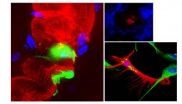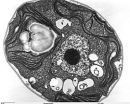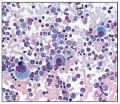(Press-News.org) When the going gets tough, grape seed extract gets going: A University of Colorado Cancer Center study recently published in the journal Cancer Letters shows that the more advanced are colorectal cancer cells, the more GSE inhibits their growth and survival. On the other end of the disease spectrum, GSE leaves healthy cells alone entirely.
"We've known for quite a while that the bioactive compounds in grape seed extract selectively target many types of cancer cells. This study shows that many of the same mutations that allow colorectal cancer cells to metastasize and survive traditional therapies make them especially sensitive to treatment with GSE," says Molly Derry, doctoral candidate in the lab of Rajesh Agarwal, PhD, investigator at the CU Cancer Center and professor at the Skaggs School of Pharmacy and Pharmaceutical Sciences.
Derry notes this is an especially important finding in light of increasing colorectal cancer rates (due in part to increasingly high-fat diets and sedentary lifestyles) and a low screening rate; that means 60 percent of patients diagnosed have already reached the advanced stage of the disease.
"Finding a way to selectively target advanced colorectal cancer cells could have major clinical importance," Derry says.
The group performed their experiments on colorectal cancer cell lines representing various stages of the disease. Whereas it generally takes much more chemotherapy to kill a stage IV cancer cell than a stage II cancer cell, Derry saw that the reverse was true with grape seed extract.
"It required less than half the concentration of GSE to suppress cell growth and kill 50 percent of stage IV cells than it did to achieve similar results in the stage II cells," Derry says.
The group also discovered a likely mechanism of GSE's preferential targeting of advanced colorectal cancer cells: when cancer cells were treated with antioxidants the GSE induced cell death was reversed and so Derry and colleagues consider it likely that GSE targets colorectal cancer through inducing oxidative stress that leads to the programmed cell death known as apoptosis.
"A colorectal cancer cell can have upwards of 11,000 genetic mutations – differences from the DNA in healthy cells. Traditional chemotherapies may only target a specific mutation and as cancer progresses more mutations occur. These changes can result in cancer that is resistance to chemotherapy. In contrast, the many bioactive compounds of GSE are able to target multiple mutations. The more mutations a cancer presents, the more effective GSE is in targeting them," Derry says.
The Agarwal Lab continues its preclinical work studying the effectiveness and action of dietary compounds against cancer and encourages further exploration of their findings in clinical settings.
### END
As colorectal cancer gets more aggressive, treatment with grape seed extract is even more effective
Stage IV cancer cells even more susceptible to GSE than stage II cancer
2013-01-17
ELSE PRESS RELEASES FROM THIS DATE:
Pandemic vaccination did not increase risk of fetal death
2013-01-17
With the rapid progression of molecular biology and genetics, and the subsequent emergence of many new targets, emerging targets & therapeutics provides new opportunities for the prevention and treatment of several major disease systems. The 4th Cancer Targets & Therapeutics Conference, taking place on February 25-26, 2013 in Las Vegas, NV will continue to be a premier event for translational researchers, preclinical scientists and managers, and those carrying out early phase clinical trials, working to identify and exploit advances in the field in order to deliver products ...
Photovoltaics beat biofuels at converting sun's energy to miles driven
2013-01-17
In 2005, President George W. Bush and American corn farmers saw corn ethanol as a promising fossil fuel substitute that would reduce both American dependence on foreign oil and greenhouse gas emissions. Accordingly, the 2005 energy bill mandated that 4 billion gallons of renewable fuel be added to the gasoline supply in 2006. That rose to 4.7 billion gallons in 2007 and 7.5 billion in 2012.
Since then, life cycle assessments (LCAs) have shown that corn ethanol has modest if any effect on reducing CO2 emissions and may actually increase them, while posing a threat to natural ...
New research throws doubt on earlier 'killer walrus' claims
2013-01-17
Palaeontologists who examined a new fossil found in southern California have thrown doubt on earlier claims that a "killer walrus" once existed.
Geology PhD student Robert Boessenecker from New Zealand's University of Otago and co-author Morgan Churchill from the University of Wyoming have today published their paper about the fossil in the online scientific journal PLOS ONE.
The paper reports that the new fossil-find, of the extinct walrus Pelagiarctos from southern California, prompts a different hypothesis to an earlier one that a "killer walrus" existed, preying ...
New study examines post-Roe v. Wade arrests of and forced interventions on pregnant women
2013-01-17
"Arrests of and Forced Interventions on Pregnant Women in the United States, 1973-2005: Implications for Women's Legal Status and Public Health," an article by Lynn M. Paltrow and Jeanne Flavin in the Journal of Health Politics, Policy and Law (volume 38, issue 2), offers a groundbreaking, in-depth look at criminal and civil cases in which a woman's pregnancy was a deciding factor leading to attempted and actual deprivations of her physical liberty.
As "personhood" measures are promoted and the fortieth anniversary of Roe v. Wade approaches, this article broadens the ...
Quail really know their camouflage
2013-01-17
When it comes to camouflage, ground-nesting Japanese quail are experts. That's based on new evidence published online on January 17 in Current Biology that mother quail "know" the patterning of their own eggs and choose laying spots to hide them best.
"Not only are the eggs camouflaged, but the birds choose to lay their eggs on a substrate that maximizes camouflage," said P. George Lovell of Abertay University and the University of St Andrews. "Furthermore, the maximization seems specific to individual birds."
Karen Spencer, also of University of St Andrews and a co-author, ...
New insights into how leprosy infection spreads could pave the way for early intervention
2013-01-17
Leprosy is a bacterial disease that spreads to muscles and other tissues in the body, causing neurodegeneration and muscle weakness. A new study, published by Cell Press January 17th in the journal Cell, reveals that the bacteria responsible for leprosy spread infection by hijacking specialized cells in the adult nervous system, reprogramming them into a stem cell-like state, and converting them to muscle-like cells. These findings could lead to the development of new therapeutic strategies for combating bacterial infections and degenerative diseases as well as new tools ...
Learning the alphabet of gene control
2013-01-17
Scientists at Karolinska Institutet in Sweden have made a large step towards the understanding of how human genes are regulated. In a new study, published in the journal Cell, they identified the DNA sequences that bind to over four hundred proteins that control expression of genes. This knowledge is required for understanding of how differences in genomes of individuals affect their risk to develop disease.
After the human genome was sequenced in 2000, it was hoped that the knowledge of the entire sequence of human DNA could rapidly be translated to medical benefits ...
Cancer mortality down 20 percent from 1991 peak
2013-01-17
Atlanta– Jan. 17, 2013–As of 2009, the overall death rate for cancer in the United States had declined 20 percent from its peak in 1991, translating to the avoidance of approximately 1.2 million deaths from cancer, 152,900 of these in 2009 alone. These figures come from the American Cancer Society's annual Cancer Statistics report, one of the most widely-cited medical publications in the world.
Each year, the American Cancer Society estimates the numbers of new cancer cases and deaths expected in the United States in the current year and compiles the most recent data ...
How cells know when it's time to eat themselves
2013-01-17
Researchers at the University of California, San Diego School of Medicine have identified a molecular mechanism regulating autophagy, a fundamental stress response used by cells to help ensure their survival in adverse conditions.
The findings are published online in the January 17 issue of Cell.
Senior author Kun-Liang Guan, PhD, a professor of pharmacology at UC San Diego Moores Cancer Center, and colleagues report that an enzyme called AMPK, typically involved in sensing and modulating energy use in cells, also regulates autophagic enzymes.
Autophagy, which derives ...
Drug targets hard-to-reach leukemia stem cells responsible for relapses
2013-01-17
Researchers at the University of California, San Diego School of Medicine have discovered that hard-to-reach, drug-resistant leukemia stem cells (LSCs) that overexpress multiple pro-survival protein forms are sensitive – and thus vulnerable – to a novel cancer stem cell-targeting drug currently under development.
The findings, published in the January 17 online issue of Cell Stem Cell, open the possibility that diseases like chronic myeloid leukemia (CML) and some solid tumor cancers might – in combination with other therapies – be more effectively treated with this ...
LAST 30 PRESS RELEASES:
Heart-brain connection: international study reveals the role of the vagus nerve in keeping the heart young
Researchers identify Rb1 as a predictive biomarker for a new therapeutic strategy in some breast cancers
Survey reveals ethical gaps slowing AI adoption in pediatric surgery
Stimulant ADHD medications work differently than thought
AI overestimates how smart people are, according to HSE economists
HSE researchers create genome-wide map of quadruplexes
Scientists boost cell "powerhouses" to burn more calories
Automatic label checking: The missing step in making reliable medical AI
Low daily alcohol intake linked to 50% heightened mouth cancer risk in India
American Meteorological Society announces Rick Spinrad as 2026 President-Elect
Biomass-based carbon capture spotlighted in newly released global climate webinar recording
Illuminating invisible nano pollutants: advanced bioimaging tracks the full journey of emerging nanoscale contaminants in living systems
How does age affect recovery from spinal cord injury?
Novel AI tool offers prognosis for patients with head and neck cancer
Fathers’ microplastic exposure tied to their children’s metabolic problems
Research validates laboratory model for studying high-grade serous ovarian cancer
SIR 2026 delivers transformative breakthroughs in minimally invasive medicine to improve patient care
Stem Cell Reports most downloaded papers of 2025 highlight the breadth and impact of stem cell research
Oxford-led study estimates NHS spends around 3% of its primary and secondary care budget on the health impacts of heat and cold in England
A researcher’s long quest leads to a smart composite breakthrough
Urban wild bees act as “microbial sensors” of city health.
New study finds where you live affects recovery after a hip fracture
Forecasting the impact of fully automated vehicle adoption on US road traffic injuries
Alcohol-related hospitalizations from 2016 to 2022
Semaglutide and hospitalizations in patients with obesity and established cardiovascular disease
Researchers ‘listen in’ to embryo-mother interactions during implantation using a culture system replicating the womb lining
How changing your diet could help save the world
How to make AI truly scalable and reliable for real-time traffic assignment?
Beyond fragmented markets: A new framework for efficient and stable ride-pooling
Can shape priors make road perception more reliable for autonomous driving?
[Press-News.org] As colorectal cancer gets more aggressive, treatment with grape seed extract is even more effectiveStage IV cancer cells even more susceptible to GSE than stage II cancer




